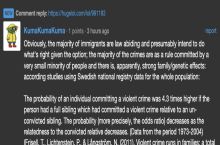KumaKumaKuma · 3 points ·
I missed it, is there a link to it or something?
 RAUS -- AUSLÄNDER RAUS
RAUS -- AUSLÄNDER RAUS This is all that I have read up on recently: anything else and I would have to either dig deep(er) in my memory or indulge in conjecture :3
This is all that I have read up on recently: anything else and I would have to either dig deep(er) in my memory or indulge in conjecture :3
Joined 4 years ago (2021-02-13 11:40:09).
Has 20,127 Karma.
Created 177 posts.
Wrote 2,779 comments.

 *I am patiently awaiting Jrlol3 to either confirm or reject the veracity of this...
*I am patiently awaiting Jrlol3 to either confirm or reject the veracity of this...


 I'm pretty sure my best years are already behind me
I'm pretty sure my best years are already behind me


 I agree with this post 100%
I agree with this post 100%
 RAUS -- AUSLÄNDER RAUS
AUSLÄNDER RAUS
DEUTSCHLAND DEN DEUTCHEN,
AUSLÄNDER...
RAUS -- AUSLÄNDER RAUS
AUSLÄNDER RAUS
DEUTSCHLAND DEN DEUTCHEN,
AUSLÄNDER...
 And I'll do it again
And I'll do it again
 This is all that I have read up on recently: anything else and I would have to e...
This is all that I have read up on recently: anything else and I would have to e...
replydetachattach picture